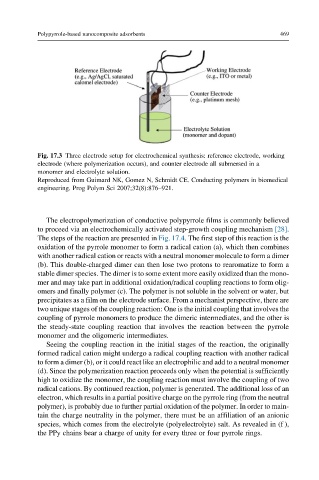Page 516 - Polymer-based Nanocomposites for Energy and Environmental Applications
P. 516
Polypyrrole-based nanocomposite adsorbents 469
Fig. 17.3 Three electrode setup for electrochemical synthesis: reference electrode, working
electrode (where polymerization occurs), and counter electrode all submersed in a
monomer and electrolyte solution.
Reproduced from Guimard NK, Gomez N, Schmidt CE. Conducting polymers in biomedical
engineering. Prog Polym Sci 2007;32(8):876–921.
The electropolymerization of conductive polypyrrole films is commonly believed
to proceed via an electrochemically activated step-growth coupling mechanism [28].
The steps of the reaction are presented in Fig. 17.4. The first step of this reaction is the
oxidation of the pyrrole monomer to form a radical cation (a), which then combines
with another radical cation or reacts with a neutral monomer molecule to form a dimer
(b). This double-charged dimer can then lose two protons to rearomatize to form a
stable dimer species. The dimer is to some extent more easily oxidized than the mono-
mer and may take part in additional oxidation/radical coupling reactions to form olig-
omers and finally polymer (c). The polymer is not soluble in the solvent or water, but
precipitates as a film on the electrode surface. From a mechanist perspective, there are
two unique stages of the coupling reaction: One is the initial coupling that involves the
coupling of pyrrole monomers to produce the dimeric intermediates, and the other is
the steady-state coupling reaction that involves the reaction between the pyrrole
monomer and the oligomeric intermediates.
Seeing the coupling reaction in the initial stages of the reaction, the originally
formed radical cation might undergo a radical coupling reaction with another radical
to form a dimer (b), or it could react like an electrophilic and add to a neutral monomer
(d). Since the polymerization reaction proceeds only when the potential is sufficiently
high to oxidize the monomer, the coupling reaction must involve the coupling of two
radical cations. By continued reaction, polymer is generated. The additional loss of an
electron, which results in a partial positive charge on the pyrrole ring (from the neutral
polymer), is probably due to further partial oxidation of the polymer. In order to main-
tain the charge neutrality in the polymer, there must be an affiliation of an anionic
species, which comes from the electrolyte (polyelectrolyte) salt. As revealed in (f ),
the PPy chains bear a charge of unity for every three or four pyrrole rings.

